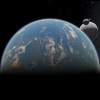|
How accurate and realistic is SpaceEngine?
|
|
| Hardts | Date: Wednesday, 05.10.2011, 18:42 | Message # 1 |
 Space Pilot
Group: Users
 Denmark
Denmark
Messages: 112
Status: Offline
| I would really like to know to what extent the Space Engine compares to the real world.
Procedural generation;
On what criteria is a planet generated, and for that matter - a sun?
What determines what kind of planets will likely exist in a system?
What determines the planetary details (ie gravity, atmospheric density, proximity from the sun, mass, diameter, moons etc)?
Or is it just all completely random  ? ?
Btw this must be the best computer program I have ever come across, thank you so much for creating it!
To all others on the forum, Hi 
i5 2500k 3,3 GHz @3,6GHz
8 GB 1600 MHz DDR3
3HDD (1TB+500GB+320GB)
Gainward Gtx 460 1GB
2 monitors: Samsung 27" P2770, 22" Samsung BW226
+A sh*tload of palmtree's around my computer :)
Edited by Hardts - Wednesday, 05.10.2011, 19:00 |
| |
| |
| SpaceEngineer | Date: Wednesday, 05.10.2011, 19:32 | Message # 2 |
 Author of Space Engine
Group: Administrators
 Russian Federation
Russian Federation
Messages: 4800
Status: Offline
| Planetary systems are generated using many physical dependences, but not accurate as I want it to be. The future development is to introduce analytical or even numerical simulation of planet formations and further evolution.
*

|
| |
| |
| Hardts | Date: Wednesday, 05.10.2011, 19:36 | Message # 3 |
 Space Pilot
Group: Users
 Denmark
Denmark
Messages: 112
Status: Offline
| Ah, I see.
May I ask what overall physical dependencies?
i5 2500k 3,3 GHz @3,6GHz
8 GB 1600 MHz DDR3
3HDD (1TB+500GB+320GB)
Gainward Gtx 460 1GB
2 monitors: Samsung 27" P2770, 22" Samsung BW226
+A sh*tload of palmtree's around my computer :)
|
| |
| |
| SpaceEngineer | Date: Wednesday, 05.10.2011, 21:51 | Message # 4 |
 Author of Space Engine
Group: Administrators
 Russian Federation
Russian Federation
Messages: 4800
Status: Offline
| Mass-radius relations for planetary bodies, luminosity-radius-temperature-mass relations for stars, orbit stability testing, Roche limit testing, rotation rate - mass relations, rotation deceleration due to tidal forces, atmosphere pressure - density -temperature relations, atmosphere dissipation with time, and much more 
*

|
| |
| |